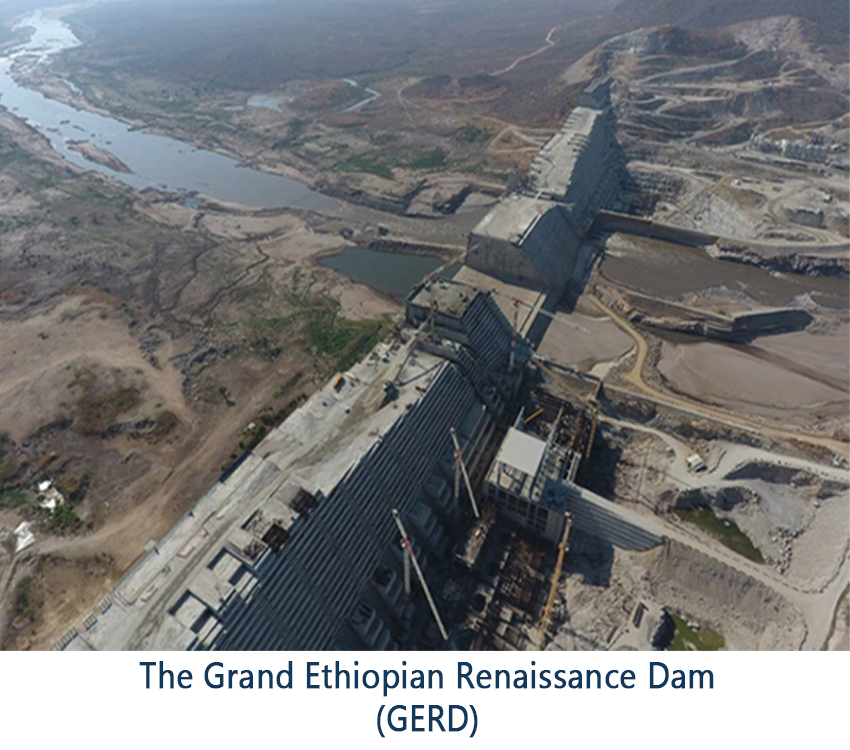Facts on GERD
What is GERD
- GERD is an acronym for Grand Ethiopian Renaissance Dam, which is currently under construction on the Abbay River course (Blue Nile), mainly for hydropower generation. GERD will be the largest hydropower plant not only in Ethiopia but also in Africa.
- 86% of the Nile flows from Ethiopia. The GERD is the first major hydroelectric dam Ethiopia is building over the Nile. The Dam is non-consumptive and its objective is to ease the adverse water scarcity in the country.
When did the construction off GERD start?
The construction of the GERD was inaugurated in April 2011 by late Prime Minister Meles Zenawi. The project was made public first as Millennium Dam and finally Grand Ethiopian Renaissance Dam and sometimes shortly referred as Renaissance Dam. The Dam was announced on March 12, 2011; a contract was signed with Salini and cornerstone placed on April 2, 2011.
Who is financing GERD?
The GERD is financed by the Ethiopian people through a sale of bond and cash contributions. The government employees, business owners, and citizens of Ethiopian origin in the diaspora participated in the purchase of the bond.
What is the installed capacity of GERD?
It was planned to have an installed capacity of 6,450MW but recently the installed capacity was revised to 5,150 MW. The expected average annual energy production is 15,700 GWh.
What are the benefits of GERD to Ethiopia?
Over 65 million Ethiopians do not have access to electricity. Rain fed agriculture on which over 80% of the population depends for subsistence is increasingly becoming unreliable. Ethiopia does not possess known significant amount of ground water resources or aquifers nor does it have access to sea water for desalination. Famine is a constant threat. Due to climate change, rain is erratic more frequently. With the country’s total energy production of less than 5000 MW and rising energy demand Ethiopia is suffering from energy insecurity. Therefore, the completion of the GERD will ensure,
- Increased electricity generation capacity to meet industrial and domestic energy demands.
- Expanded economic activities in the fishery, recreation and tourism sectors enhancing better employment opportunities.
- Accelerated structural transformation of Ethiopia’s economy thereby providing opportunity to reduce people living in extreme poverty.
- Enhanced opportunities for economic integration.
- Improved electric energy access to Djibouti, Egypt, Eritrea, Kenya, Sudan, and Somalia.
- Enhanced foreign currency earnings through export of electricity.
How does the GERD benefit the lower stream countries?
Sudan
- Reduces dredging and infrastructure maintenance costs
- Prolongs lifetime of the dams downstream.
- Improves capacity of the underperforming hydropower schemes.
- Reduces the amount of water lost due to evaporation.
- Provides sustainable and regulated flow of water stored in the Ethiopian highlands where evaporation is much less than in the lowlands of downstream.
- Enhances agricultural production.
- Reduces seasonal flooding of the plains surrounding the reservoir of the Roseires.
- Mitigates drought and flood.
Egypt
- Reduces dredging and infrastructure maintenance costs.
- Prolongs lifetime of the dams.
- Improves capacity of the underperforming hydropower schemes.
- Enhances conservation of water by reducing water loss at High Aswan Dam.
- Lowers the Nile water lost at the HAD for evaporation.
- Provides sustainable and regulated flow of water stored in the Ethiopian highlands where evaporation is much less than in the lowlands of downstream.
- Enhances agricultural production.
- Mitigates drought and flood.
- Promotes the possibility for maximizing mutual benefits whereby countries could complement each other in order to make the most efficient use of the Nile water resources.
Ethiopia’s effort for cooperation on the Nile river
- Since the 1990s Ethiopia has been spearheading the regional effort, in collaboration with all riparian countries of the River Nile, with financial and technical support from the international community to put in place a new basin-wide, water governance arrangement that would enable rules-based, equitable, sustainable, cooperative management and development of the Nile water resources that would benefit all while promoting peace and security in the region. This was pursued through the Nile Basin Initiative (NBI) and also supporting the negotiations for a new Nile-Basin wide legal regime, namely the Agreement on the Nile River Basin Cooperative Framework (CFA). Ethiopia tirelessly strove toward the establishment of fairer, more equitable, all-inclusive and multilateral regime in Nile Basin.

